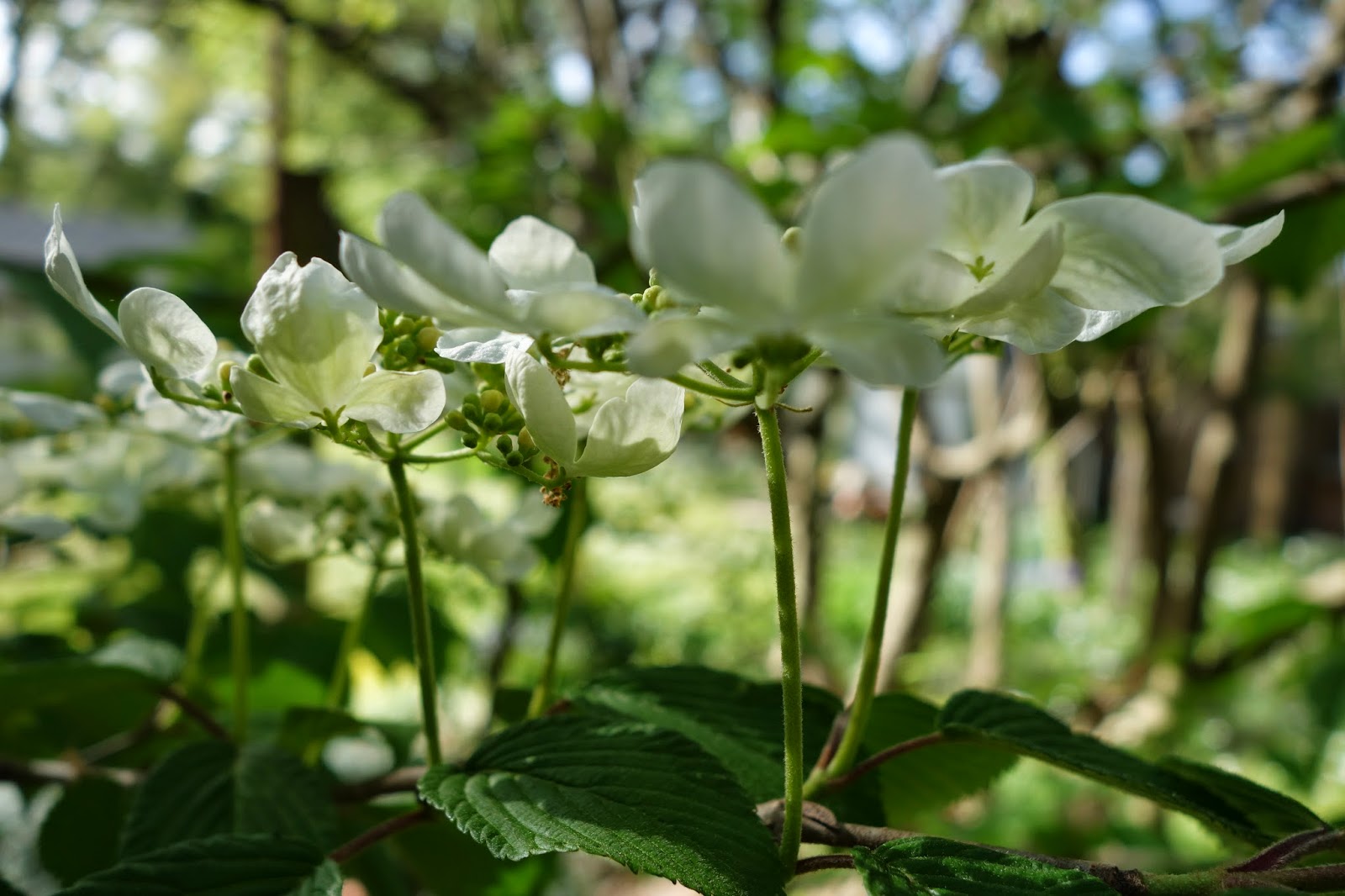Tuesday, April 29, 2014
Chives and rhododendrons
A big storm is headed our way, so here are some purple blooms before they get walloped by more rain...
Wednesday, April 23, 2014
Tulips are out, azaleas are in
Spring is lasting much longer than usual this year, with enough cool days to spread out the blooming schedules of the different flowers. Here's what's currently in bloom around our house:
Monday, April 21, 2014
A Tale of Six Books
Am I busy finishing A Tale of Two Cities? No--but I interrupt my literary slackitude to bring you a tale of six books. Seven books, actually, but only six of them mine, and none of them fiction, thank goodness. This is one of those rare stories in which real life imitates a novel.
Here goes:
During the Great Purge, I made a lot of choices, obviously, about what to pull from the shelves. Some choices were easy, some were hard, and some took serious nudging and emotional support from friends. In the end, multiple boxes of books and CDs went to the nonprofit "Friends of the Public Library," from where they will hopefully find their way into hands and hearts that will enjoy them anew.
One particular set of books was too special for such purging while simultaneously too good to simply gather dust on my shelf: Sir Donald Francis Tovey's Essays in Musical Analysis--cloth-bound hard-cover printings from the mid-1940s, in excellent condition, all six volumes. Tovey was a musical jack-of-all-trades--musicologist, pianist, composer, conductor, analyst, and editor. The Essays in Musical Analysis were collected from his insightful program notes for the Reid Orchestra at the University of Edinburgh. They're classics.
I had coveted these books when I was in grad school at the University of Wisconsin-Madison in the 1990s, but the copies I had seen in the local used books store was beyond my budget. I acquired my set when a fellow grad student bailed from the program; he sold me a ton of books, all of them highly desirable to music theory geeks, for a mere $200, including the Tovey set.
The books moved with me to my first teaching gig in Kansas, and then to my second gig at Duke in North Carolina. I followed my friend out of the discipline in 2003, and all of the other books eventually ended up in the hands of a later generation of grad students, but I kept the Tovey Essays through every baby-step purge. The Great Purge of 2014 was different: the books had to go, but were too special to just give away to strangers.
I offered to ship them to former classmates who had remained in academia. No one jumped at the offer; as one explained, "thanks Liz, but I don't need any more unread books on my shelf mocking me (as [our advisor] used to say)." Some voted for eBay, but I feared a buyer would split the set up. One friend agreed, urging "c'mon, Liz. Keep 'em. They're classics. Beautiful little time capsules (in more than one sense). Every time you sell a volume, a program annotator cries."
So I put the books aside on the roll-top desk in the living room. Two months later, I was cleaning off the desk (we clean in our house largely by moving piles of stuff from one location to another) and decided the time had finally come for them to move on.
I had heard about a relatively new used-books store downtown. I've never been there, because, as you know, either I dislike reading or I'm too busy slogging my way through A Tale of Two Cities to buy more books. Whatever. I went to the bookstore's website, saw that they were in a historic city-center building with pressed-tin ceilings, and thought that folks who appreciate old urban architecture and old books might understand the emotional investment I had in a Tovey set I had barely read but nonetheless still cherished; perhaps they would be interested in them.
I started drafting an angst-filled email inquiry and wanted to accurately describe the condition of the books. They were in excellent shape for 70-year-olds, but I recalled that they did have some markings inside the front covers. I opened one volume to confirm that, and saw the Ex Libris plate, dated 1948--itself an antique. All six books had the same plate and date. I didn't recognize the previous owner's name, but thought it might be of interest, so I googled it. The search engine returned a few links, with More Familiar Name often included. Additional googling followed, plus a closer inspection of the pencil scrawlings inside the covers, where I found More Familiar's name written in cursive.
More Familiar is a former colleague of mine at Duke.
The books had belonged to More Familiar's first wife, a scholar in the performance practice movement who died, too young, in 1974. She had been a teenager when she put her Ex Libris plates in the books. More Familiar had taught in Madison for a few years in the 1970s before coming to Duke.
I emailed More Familiar and asked if he'd like the books. He wrote back that he had consulted volume VII just the week before and was wishing he had kept the rest of the set. I hadn't even known there was a volume VII.
So there it ended: the Tovey collection that was too good to randomly give away, too good to split up, and too good to sit unread was happily reunited with More Familiar, 1000+ miles and 40 years after he and the books had parted ways.
Here goes:
During the Great Purge, I made a lot of choices, obviously, about what to pull from the shelves. Some choices were easy, some were hard, and some took serious nudging and emotional support from friends. In the end, multiple boxes of books and CDs went to the nonprofit "Friends of the Public Library," from where they will hopefully find their way into hands and hearts that will enjoy them anew.
One particular set of books was too special for such purging while simultaneously too good to simply gather dust on my shelf: Sir Donald Francis Tovey's Essays in Musical Analysis--cloth-bound hard-cover printings from the mid-1940s, in excellent condition, all six volumes. Tovey was a musical jack-of-all-trades--musicologist, pianist, composer, conductor, analyst, and editor. The Essays in Musical Analysis were collected from his insightful program notes for the Reid Orchestra at the University of Edinburgh. They're classics.
I had coveted these books when I was in grad school at the University of Wisconsin-Madison in the 1990s, but the copies I had seen in the local used books store was beyond my budget. I acquired my set when a fellow grad student bailed from the program; he sold me a ton of books, all of them highly desirable to music theory geeks, for a mere $200, including the Tovey set.
The books moved with me to my first teaching gig in Kansas, and then to my second gig at Duke in North Carolina. I followed my friend out of the discipline in 2003, and all of the other books eventually ended up in the hands of a later generation of grad students, but I kept the Tovey Essays through every baby-step purge. The Great Purge of 2014 was different: the books had to go, but were too special to just give away to strangers.
I offered to ship them to former classmates who had remained in academia. No one jumped at the offer; as one explained, "thanks Liz, but I don't need any more unread books on my shelf mocking me (as [our advisor] used to say)." Some voted for eBay, but I feared a buyer would split the set up. One friend agreed, urging "c'mon, Liz. Keep 'em. They're classics. Beautiful little time capsules (in more than one sense). Every time you sell a volume, a program annotator cries."
So I put the books aside on the roll-top desk in the living room. Two months later, I was cleaning off the desk (we clean in our house largely by moving piles of stuff from one location to another) and decided the time had finally come for them to move on.
I had heard about a relatively new used-books store downtown. I've never been there, because, as you know, either I dislike reading or I'm too busy slogging my way through A Tale of Two Cities to buy more books. Whatever. I went to the bookstore's website, saw that they were in a historic city-center building with pressed-tin ceilings, and thought that folks who appreciate old urban architecture and old books might understand the emotional investment I had in a Tovey set I had barely read but nonetheless still cherished; perhaps they would be interested in them.
I started drafting an angst-filled email inquiry and wanted to accurately describe the condition of the books. They were in excellent shape for 70-year-olds, but I recalled that they did have some markings inside the front covers. I opened one volume to confirm that, and saw the Ex Libris plate, dated 1948--itself an antique. All six books had the same plate and date. I didn't recognize the previous owner's name, but thought it might be of interest, so I googled it. The search engine returned a few links, with More Familiar Name often included. Additional googling followed, plus a closer inspection of the pencil scrawlings inside the covers, where I found More Familiar's name written in cursive.
More Familiar is a former colleague of mine at Duke.
The books had belonged to More Familiar's first wife, a scholar in the performance practice movement who died, too young, in 1974. She had been a teenager when she put her Ex Libris plates in the books. More Familiar had taught in Madison for a few years in the 1970s before coming to Duke.
I emailed More Familiar and asked if he'd like the books. He wrote back that he had consulted volume VII just the week before and was wishing he had kept the rest of the set. I hadn't even known there was a volume VII.
So there it ended: the Tovey collection that was too good to randomly give away, too good to split up, and too good to sit unread was happily reunited with More Familiar, 1000+ miles and 40 years after he and the books had parted ways.
Labels:
books,
cultural literacy,
music,
purge,
small world
Monday, April 14, 2014
Friday, April 11, 2014
Herons and more tulip private parts
We had a friend in town yesterday with a bit of free time in the afternoon, so we took him to Duke Gardens. I was at the gardens about two weeks ago with some other friends, and we had the surprising privilege of watching a heron stab and devour a fish from the koi pond. We saw a heron yesterday too, and moments after I aimed my camera at it, in the blink of an eye, it flew into the water and snarfed down a fish. So to all you herons out there reading this, Duke Gardens is the place to be right now.
Because I'm in the habit, I couldn't resist taking more photos of tulip private parts. Seems like a pollinator would have to be pretty obtuse not to hone in on these things.
We have lots of pollen at home too, judging by the cat's head.
 |
| Catch it |
 |
| Silence it |
 |
| Swallow it |
Because I'm in the habit, I couldn't resist taking more photos of tulip private parts. Seems like a pollinator would have to be pretty obtuse not to hone in on these things.
We have lots of pollen at home too, judging by the cat's head.
Saturday, April 5, 2014
What kind of person am I? A Tale of Two Cities update
Maybe my 6th-grade teacher was right, and I shouldn't have written quite so effusively about A Tale of Two Cities before finishing the book.
As my literary experiment limps on, I am coming to the conclusion that I just don't much like to read classic adult fiction. After my previous post on the book, I let A Tale of Two Cities sit in the trunk of my car for two months, then picked it up again during one of E's band practices.
Did I previously write that Lucie Manette is "a little too diminutive"? That was mighty generous of me. She's so sincere and delicate and at-the-service-of-others that she's hardly human. She's earnest and pretty and boring.
I had high hopes for this book, especially following The Scarlet Letter. Where Hawthorne is just mean, Dickens is amusingly snarky. For example, whereas Hawthorne repeatedly harps on his Custom-House colleagues for tipping their chairs backward and snoozing their mind-numbingly dull days away, Dickens more vividly and cheerfully compares bankers to cheese:
Upon retrieving it, I wondered why on earth a teacher would offer this text to 11-yr-olds. The language is occasionally so oblique that even as a 46-yr-old skimmer, I'm not entirely certain I'm understanding it correctly. I picked up that Charles wanted to marry Lucie, and then that Charles was indeed going to marry Lucie, and then that they were married and off on their honeymoon; and then in the course of a page or so (pp. 161-162), I thought I read that Lucie maybe nearly died during pregnancy or childbirth, and they had a daughter, and then also a son, but the angelic boy died as a young child. What? Did I read that right? I re-skimmed the pages and still wasn't sure, so I tried googling for confirmation.
That was a mistake, because instead of finding confirmation, I found a SPOILER that indicates that the interesting, clever, revolutionary, strong female character--Madame Dufarge--is "the villainess in the novel," and as such, is going to get bumped off by Lucie Manette's proxy, Miss Pross. I haven't gotten far enough into the book to understand that Madame Dufarge is "a monster"--just far enough to admire her involvement in espionage and observant knitting. Dang.
This reminds me of another book I read (and actually enjoyed): Gregory Maguire's Lost (2001). I don't remember much about the book, other than that it had something to do with Dickens and Scrooge and ghosts or some such, but I do remember really liking the female protagonist, Winifred Rudge. The edition I owned had some questions for reading groups, and I recall one of the questions saying something along the lines of, "Many readers find Winifred Rudge to be extremely unlikable blah blah blah"--which made me wonder what kind of person I must be if I liked her. And here I am, enthusiastically preferring Madame Dufarge to the feminine ideal of Lucie Manette. Oh dear, oh dear, and I still have 130 pages to go.
As my literary experiment limps on, I am coming to the conclusion that I just don't much like to read classic adult fiction. After my previous post on the book, I let A Tale of Two Cities sit in the trunk of my car for two months, then picked it up again during one of E's band practices.
Did I previously write that Lucie Manette is "a little too diminutive"? That was mighty generous of me. She's so sincere and delicate and at-the-service-of-others that she's hardly human. She's earnest and pretty and boring.
I had high hopes for this book, especially following The Scarlet Letter. Where Hawthorne is just mean, Dickens is amusingly snarky. For example, whereas Hawthorne repeatedly harps on his Custom-House colleagues for tipping their chairs backward and snoozing their mind-numbingly dull days away, Dickens more vividly and cheerfully compares bankers to cheese:
Cramped in all kinds of dim cupboards and hutches at Tellson's, the oldest of men carried on the business gravely. When they took a young man into Tellson's London house, they hid him somewhere till he was old. They kept him in a dark place, like a cheese, until he had the full Tellson flavour and blue-mould upon him. Then only was he permitted to be seen, spectacularly poring over large books, and casting his breeches and gaiters into the general weight of the establishment. (Dover Thrift Edition, 1999, p. 40).When Dickens coined the adverb "adverbiously," I practically swooned:
Charles Darnay had yesterday pleaded Not Guilty to an indictment denoucing him (with infinite jingle and jangle) for that he was a false traitor to our serene, illustrious, excellent, and so forth, prince, our Lord the King, by reason of his having, on divers occasions, and by divers means and ways, assisted Lewis, the French King, in his wars against our said serene, illustrious, excellent, and so forth; that was to say, by coming and going between the dominions of our said serene, illustrious, excellent, and so forth, and those of the said French Lewis, and wickedly, falsely, traitorously, and otherwise evil-adverbiously, revealing to the said French Lewis what forces our said serene, illustrious, excellent, and so forth, had in preparation to send to Canada and North America. (pp. 46-47)But somehow the excitement dropped off somewhere in France, especially as attention turned to the solemn and rather boring love between Lucie Manette and Charles Darnay. Thus I hid the book in the trunk.
Upon retrieving it, I wondered why on earth a teacher would offer this text to 11-yr-olds. The language is occasionally so oblique that even as a 46-yr-old skimmer, I'm not entirely certain I'm understanding it correctly. I picked up that Charles wanted to marry Lucie, and then that Charles was indeed going to marry Lucie, and then that they were married and off on their honeymoon; and then in the course of a page or so (pp. 161-162), I thought I read that Lucie maybe nearly died during pregnancy or childbirth, and they had a daughter, and then also a son, but the angelic boy died as a young child. What? Did I read that right? I re-skimmed the pages and still wasn't sure, so I tried googling for confirmation.
That was a mistake, because instead of finding confirmation, I found a SPOILER that indicates that the interesting, clever, revolutionary, strong female character--Madame Dufarge--is "the villainess in the novel," and as such, is going to get bumped off by Lucie Manette's proxy, Miss Pross. I haven't gotten far enough into the book to understand that Madame Dufarge is "a monster"--just far enough to admire her involvement in espionage and observant knitting. Dang.
This reminds me of another book I read (and actually enjoyed): Gregory Maguire's Lost (2001). I don't remember much about the book, other than that it had something to do with Dickens and Scrooge and ghosts or some such, but I do remember really liking the female protagonist, Winifred Rudge. The edition I owned had some questions for reading groups, and I recall one of the questions saying something along the lines of, "Many readers find Winifred Rudge to be extremely unlikable blah blah blah"--which made me wonder what kind of person I must be if I liked her. And here I am, enthusiastically preferring Madame Dufarge to the feminine ideal of Lucie Manette. Oh dear, oh dear, and I still have 130 pages to go.
Friday, April 4, 2014
Spring has sprung, ed. 2014
With the flip of a switch, The Long Winter is over. E's school had a teacher work day today, so we took a stroll downtown to see what we could see. Photo dump is below. I remain surprised and impressed by the resolution of my new camera; it enables me to see details--pollen grains, furled buds--that I likely wouldn't otherwise notice.
 |
| I love phlox. Fortunately, our neighbors have lots of it. |
 |
| Another neighbor has a yard carpeted with these little flowers. |
 |
| E noticed that while most blooms have 6 petals, some have 8. |
 |
| 6 + 8 together |
 |
| They're striking viewed from underneath |
 |
| My namesake |
 |
| The Durham Arts Council inspires greatness. |
Subscribe to:
Posts (Atom)























































.jpg)














